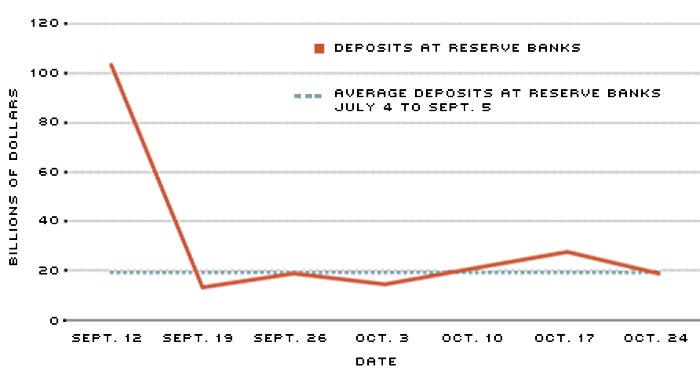The Federal Reserve's Response to the Sept. 11 Attacks
The terrorist attacks on the World Trade Center and the Pentagon were not only a human tragedy but also had potentially serious ramifications for the economy.
The most immediate economic effect of the attacks was a temporary inability to clear checks, caused by the suspension of flights. In addition, the New York Stock Exchange and other financial markets closed for the rest of the week. Many individuals, perhaps fearful of further attacks, withdrew money from the bank. Similarly, businesses moved money from illiquid assets, like stocks and bonds, to liquid assets, like checking accounts.
In the medium term, the attacks have reduced consumption and investment through their effects on consumer confidence and the temporary fall in stock prices. This reduction in consumption and investment exacerbated the economic slowdown that was already developing. In the month after the attack, for example, the Blue Chip Consensus GDP growth forecast for 2001 was revised down from 1.6 percent to 1.1 percent, and the same figure for 2002 fell from 2.7 percent to 1.5 percent.
In the longer term, resources will shift to law enforcement and defense, away from the production of other goods and services. As law enforcement and defense are mostly provided by the government, taxes will rise somewhat to pay for them. Also, many of the productive resources destroyed in the attacks will be replaced. The size of these effects can easily be overstated, however. Compared to the whole U.S. economy, the increased security outlays will be very small.
The attacks will also shift resources among industries in the longer term by raising the costs of activities like travel, postal services, security and insurance. That is, travelers will require more security to fly, and firms will have to pay more for a given level of property insurance for a downtown office building. These higher costs will reduce the quantity of travel, tourism and construction produced and consumed.
The Fed Provides Liquidity
The Federal Reserve's response to the immediate effects of the attacks was to provide liquidity—the ability to make payments—to firms and individuals. Particularly important was providing liquidity to financial firms, which constantly buy and sell assets, because they must make payments with either funds from recently sold assets or money borrowed from banks. During times of crisis, however, banks avoid making such loans because falling asset prices threaten the value of the collateral. An interruption in bank lending to financial firms could potentially set off a domino chain of bankruptcies that would bring the financial system to a halt. Such an event would quickly disrupt the whole economy through its effect on investment, including new homes, and on durable consumer goods. To avoid such a disaster, the Federal Reserve provided emergency liquidity in five ways:
- The Fed's New York Trading Desk bought a very large amount of U.S. Treasury securities, either outright or through repurchase agreements.1 These transactions provided liquidity to markets by transferring money (a liquid asset) to the public in exchange for Treasury securities (a less liquid asset). The Fed held $61 billion of securities acquired under repurchase agreements on Sept. 12, vs. an average of $27 billion on the previous 10 Wednesdays and about $12 billion a year earlier.
- The Fed directly lent funds to banks through the discount window. The $45 billion in discount loans outstanding on Sept. 12 dwarfed the $59 million average of the previous 10 Wednesdays.
- As a regulator, the Federal Reserve—along with the Comptroller of the Currency—urged banks to restructure loans for borrowers with temporary liquidity problems. To assist such restructuring, the Fed made additional funds available.
- The Fed passively extended credit to the economy through its role in clearing checks. When the Fed clears checks, it credits the receiving bank before debiting the bank making the payment. Float describes the amount of money that has been credited to check depositors but has not yet been debited from the check writers. The float totaled almost $23 billion on Sept. 12, for example, some 30 times the average float over each of the 10 previous Wednesdays.
- The Fed took steps to boost liquidity for foreign banks with offices or subsidiaries in the United States. To enable foreign central banks to provide these resources in U.S. dollars, the Federal Reserve quickly established "swap lines" with the European Central Bank and the Bank of England and augmented the swap line with the Bank of Canada. Swap lines are similar to lines of credit; they enable central banks to temporarily exchange currencies.
The accompanying chart illustrates the scale of the Fed's liquidity injection by depicting the value of deposits at Federal Reserve banks in the six weeks following Sept. 11.2 This measure, which conveniently summarizes the ability to make payments, stood at $102 billion on Sept. 12, more than five times the average of the previous 10 Wednesdays. The emergency provision of liquidity quickly passed, however. Within three weeks, the available liquidity and the channels through which it was provided—repurchase agreements, discount lending, float, etc.—were indistinguishable from pre-attack figures.
Current Monetary Policy
The immediate extraordinary effects of the attacks were over by October. Forecasters almost unanimously predict, however, that the attacks will exacerbate the slowdown through their effects on consumer confidence, asset prices and temporary disruptions of law enforcement, defense spending, transportation and communications. In addition, because of the extraordinary and temporary effects on some sectors, like air travel, September and October economic statistics are likely to be less informative than usual regarding longer-run trends. With this in mind, the Federal Reserve has continued to conduct monetary policy to achieve its objective of full employment through an environment of stable prices.
In the past, the Federal Open Market Committee (FOMC) has responded to weaker economic conditions, which are often associated with downward pressure on the price level, with a lower federal funds target. The present case has been no exception; the FOMC reduced the federal funds rate target four times in the three months following the attacks. On Sept. 17, the FOMC lowered the target by one-half percentage point, to 3 percent, while publicly stating that future risks were weighted more heavily to economic weakness than the reverse. This action was interpreted as a confidence-boosting measure for the reopening of the New York Stock Exchange later that morning. The FOMC reinforced this action with two more 50 basis point reductions on Oct. 2 and Nov. 6 and with a 25 point reduction on Dec. 11, lowering the rate target to 1.75 percent.
Looking Ahead
Over a period of many years, the growth of any economy depends on a nation's stock of human and physical capital—that which can be used to produce goods and services—and on the legal environment for economic activity. These fundamentals were strong for the U.S. economy before the attack, and they have been little affected. Estimates of the value of the World Trade Center, the destruction at the Pentagon and of the associated physical capital have been valued between $10 billion and $70 billion. A mid-range estimate of $50 billion would be only 1/600th of the U.S. capital stock, which stood at almost $30 trillion in 2000.3 The long-term fundamentals for the U.S. economy remain very solid; long-run productivity growth is unlikely to be much changed. The events of Sept. 11 provide no reason to fundamentally change monetary policy.
Conclusions
The Fed has a mandate, by law and tradition, to provide monetary conditions for maximum sustainable growth and price stability. The Fed reacted quickly to provide liquidity during a crisis. In the aftermath of the attacks, monetary policy has been complicated by difficulty in interpreting data from September and October; however, policy has otherwise been conducted as usual. The long-term fate of the U.S. economy depends on the ingenuity and industriousness of Americans, as well as on a stable legal environment. Although the attacks may have temporarily exacerbated the slowdown, the long-term prospects for the U.S. economy are as bright as before.
Liquidity Provided in Response to Sept. 11, 2001

Immediately following the terrorist attacks of Sept. 11, the Federal Reserve provided huge amounts of liquidity to the economy. As a result, deposits at Federal Reserve banks more than quintupled over their average level the previous two months.
SOURCE: Board of Governors' H.4.1 releases, July 5 to Oct. 25, 2001. [back to text]
Endnotes
- In a repurchase agreement, or repo, the Federal Reserve agrees to purchase assets and hold them for a time and sell them back at a predetermined price in the future. [back to text]
- Deposits at Federal Reserve banks are the sum of "Service related balances and adjustments" and "Reserve balances with FR banks." [back to text]
- Macroeconomic Advisers (2001) quote estimates of the physical damages from other sources. Data on the U.S. capital stock were taken from Haver Analytics.[back to text]
References
Blue Chip Consensus. Moore, Randell E., ed. Blue Chip Economic Indicators, Aspen Publishers Inc., 10 October 2001, Vol. 26, No. 10.
Macroeconomic Advisers. "Preliminary Analysis of the Macroeconomic Effects of the September 11 Terrorist Attacks on the U.S." Macroeconomic Advisers Economic Outlook, 21 September 2001, Vol. 19, No. 8.
Views expressed in Regional Economist are not necessarily those of the St. Louis Fed or Federal Reserve System.
For the latest insights from our economists and other St. Louis Fed experts, visit On the Economy and subscribe.
Email Us


